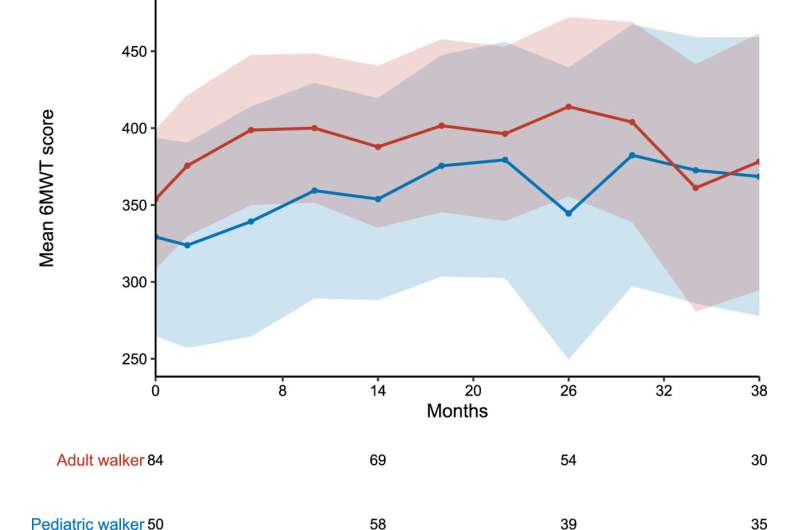This article has been reviewed according to Science X's editorial process and policies. Editors have highlighted the following attributes while ensuring the content's credibility:
fact-checked
trusted source
proofread
Study shows improved walking distance for spinal muscular atrophy patients after nusinersen treatment

A positive effect of nusinersen treatment on motor function in ambulant pediatric and adult spinal muscular atrophy (SMA) patients during a 38-month period has been demonstrated by an analysis of data from the SMArtCARE registry. Researchers not only observed a stabilization of disease progression or lack of deterioration, but clinically meaningful improvements in walking distance in a subgroup of patients. The findings of the study have been published in the Journal of Neuromuscular Diseases.
SMArtCARE is a disease-specific registry with 58 participating centers in Germany, Austria and Switzerland. Data are collected as real-world data during routine patient visits. The study's analysis included all patients being treated with nusinersen able to walk independently before the start of treatment, with a focus on changes in motor function.
Disease progression in patients with SMA has changed dramatically within the past years due to the approval of three different disease-modifying treatments. Nusinersen was the first drug to be approved for the treatment of SMA patients. Clinical trials provided data from infants with SMA type 1 and children with SMA type 2, but there is still insufficient evidence and only scarcely reported long-term experience for nusinersen treatment in ambulant patients.
Commenting on the findings of the study, lead investigator PD Dr. Astrid Pechmann, MD, Department of Neuropediatrics and Muscle Disorders, Medical Center of the University of Freiburg, Faculty of Medicine, Freiburg, Germany, says, "Real-world data from different countries and disease registries indicate that nusinersen has the potential to positively influence disease progression in ambulant patients in the short-term follow-up. However, data on the long-term effect of nusinersen in ambulant patients are still scarce. Due to reimbursement policies, this led to limited access to treatment for adult or ambulant patients in different countries."
Data from 231 ambulant patients were included in the analysis. During the observation period, changes in walking distance were assessed via the 6-Minute-Walk-Test. The study showed that 31 pediatric walkers (27.2%) and 31 adult walkers (26.5%) experienced a clinically meaningful improvement. In contrast, only five adult walkers (7.7%) showed a decline in walking distance, and two pediatric walkers (1.8%) lost the ability to walk unassisted under treatment with nusinersen.
"Our results contribute to the increasing evidence on the positive long-term effect of nusinersen treatment in this patient population. This is necessary to develop treatment recommendations, but also to facilitate and guarantee access to treatment," according to PD Dr. Pechmann.
With the leading symptom of a progressive muscle weakness and atrophy, SMA is a rare neuromuscular disorder with a broad clinical spectrum affecting patients of all ages. Disease severity is determined by different biomarkers and correlates inversely with the age at symptom onset. Patients developing the first symptoms of muscle weakness at an age older than 18 months are expected to have a milder phenotype of SMA type 3. These patients gain the ability to walk independently, but often lose ambulation as the disease progresses.
More information: Astrid Pechmann et al, Improvements in Walking Distance during Nusinersen Treatment—A Prospective 3-year SMArtCARE Registry Study, Journal of Neuromuscular Diseases (2022). DOI: 10.3233/JND-221600


















